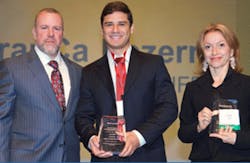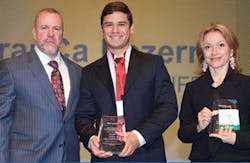A Brazilian chemical engineering student who used simulation software to show how emissions can be converted into electrical energy has been named the winner of Honeywell Process Solution’s annual UniSim Design Challenge.
Herbert Senzano Lopes, a master’s degree student at Federal University of Rio Grande do Norte (UFRN), worked with Professor Vanja Maria de França Bezerra to design a solution to show how flare gas from pipelines could be reused to generate energy.
“Maintaining production while reducing environmental waste and complying with regulations is a very real challenge for many of our customers, and this project showed how simulation can directly address it,” said Vimal Kapur, president of Honeywell Process Solutions. “Mr. Senzano and Prof. França showed how simulation software can do more than create production processes – it can create innovative solutions that reduce the environmental impact of those processes.”
With UniSim Design, Senzano and França determined how oxygen could be used to increase the electric charge of volatile organic compounds released into the air by pipeline gas flares. Their simulation created 2.126 megawatts of electrical charge and showed potential to help reduce the release of organic waste oxides in the atmosphere.
Senzano and França presented the winning entry, “Flare Gas Recovery for Electricity Generation” this week during the annual Honeywell Users Group (HUG) Americas Symposium, the company’s largest gathering of customers in the process manufacturing industries. The UniSim Design Challenge allows engineering students to propose solutions to real-world problems facing process manufacturers by using Honeywell’s UniSim Design Suite software, which is used to design and model processes in production facilities throughout the world.
"The UniSim Design was essential to our project because with this suite we could simulate a problem based on a real situation and successfully test our solution,” said Senzano. “Thanks to the software of Honeywell it was possible to build a process flowchart similar to the reality and simulate dynamic cases to the academic and manufacture sector," added França.
UniSim Design Suite is designed to provide an interactive process model that allows engineers to create steady-state and dynamic models and is used extensively for plant design, performance monitoring, troubleshooting, operational improvement, business planning, and asset management around the world. UniSim Design models may be leveraged into advanced training and optimization solutions provided by the UniSim Operations and UniSim Optimization suites.
For more information about Honeywell’s UniSim Design Challenge, go here.



